A Teacher for Krsna’s Children
Bhurijana dasa develops a school in Pennsylvania for the first generation of Krsna conscious children in the West.
by Ravindra-Svarupa Dasa
I often make the three-hour drive from Philadelphia to Gita-nagari, the Krsna conscious farm community in the fertile Juniata Valley, about fifty miles north of Harrisburg, Pennsylvania. Two of my children board at the school there. But the visit is a great pleasure for many reasons. Gita-nagari has become a place of pilgrimage for me, a source of spiritual restoration. Coming out of the hard-surfaced city, that monstrous machine for making money and ragging the senses, where devotion to God hangs in as a tenuous and frail anomaly, I enter a complete community where the devotional spirit sustains and pervades every part of it. This, a peaceful rural village, is the natural setting for Krsna consciousness. From here the play of light over forested hills rising in steps to the sky and the vast moving composition of clouds are all redolent of Krsna. Here I see people living as people are meant to live. Gita-nagari is the homeland of the soul.
To me Gita-nagari is also the future. I become acutely aware of this when I visit the school to see how the first generation of Americans born into Krsna consciousness are being brought up in devotional service. And here I can fulfill one of the main objectives of my pilgrimage: to spend time with a devotee who is fully absorbed in creating that future, the headmaster of the school my children attend, Bhurijana dasa.
I first met Bhurijana and his wife Jagattarani in 1976, when my wife Saudamani and I took our five-year-old son Yudhisthira to enroll in the school for boys at Gita-nagari. It had only recently opened, starting from scratch with ten children, but we were happy to have a school close by where we could keep our eyes on Yudhisthira and watch what was happening. For although my wife and I were both fully committed to the Krsna consciousness movement and willing to follow the direction of Srila Prabhupada, our spiritual master, in the matter of raising and educating our children, we still had large misgivings about what the school might be like.
We were convinced of the need to set up a whole alternative school system for devotee children, but we also recognized that the beginnings of such an enterprise were bound to be difficult, full of false starts and mistakes. Most devotees were rather young and inexperienced, and trial and error was the only way to build a working system.
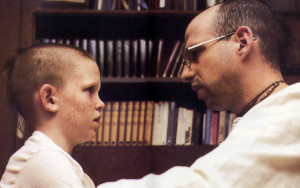
So although I immediately liked Bhurijana, one part of me measured him in a. more dispassionate and critical light. After all, I was turning my own child over to him.
Still, Saudamani and I quickly established close relations with Bhurijana and Jagattarani. At that time the boys’ school was in a small two-story building with one big classroom, two smaller rooms with child-sized bunk-beds, and one room for Bhurijana, Jagattarani, and their two-year-old daughter, Vrndavana-lila. The school was modeled on the Vedic guru-kula system, in which boys at five years go to live in the house of their guru, or spiritual master. As a representative of Srila Prabhupada, Bhurijana was much more than the boys’ academic instructor; he was their constant companion and exemplar, living closely with them to guide the formation of their character.

Character formation is one of the main goals of the gurukula system, and it requires that the students have continuous and intimate association with a teacher who instructs them by the example of his own conduct. This system naturally demanded a high standard of behavior from the teachers in Gita-nagari—not just from Bhurijana but also from Jagattarani, who saw to it that the boys were properly bathed, clothed, fed, rested, and so on. In effect, Bhurijana and Jagattarani had taken on a family of ten boys, and I was fairly awed by the heroic self-sacrifice they were rather cheerfully undertaking. While the gurukula style of education is immeasurably superior to the sort of American factory schooling I had been subjected to, I could see that it must be rough on the teacher, even if he’s a saint. “You stay with ten boys all day long?” I asked Bhurijana in amazement on one visit. “How do you stand it?” “Some days,” he said, “they drive me up the wall.” I could believe it.
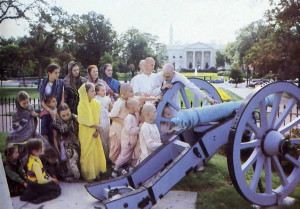
Bhurijana still speaks with the accent of his native Brooklyn, and as he entertained me with some remarkably funny descriptions of a few of the boys’ antics and habits of mind, I could place his humor as the kind that has been called New York City’s greatest cultural contribution to America, combining as it does a warm-hearted sympathy for its subject with the extremes of exacerbation. Bhurijana is very funny, and I could see how his sense of humor contributes to his composure. He is also a compulsive maker of outrageous puns. This gives his students no end of delight, and my son Yudhisthira can now spiel off a whole collection of “Bhurijana jokes.”
“I joke around a lot,” Bhurijana told me. “The hardest thing about being a teacher is that the children follow your example. So when one of the boys in geography class asked, ‘If the people from Portugal are called Portuguese, then is a person from Portugal a Portugoose?’ I realized I had gone too far.”
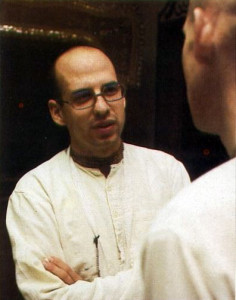
Saudamani and I soon felt sufficiently at ease with Bhurijana to be frank about our misgivings concerning gurukula education. These were mostly about academics. My wife and I had between us garnered a large store of educational experience. We were both university graduates, and I had gone on to graduate school. She had taught in elementary school; I had taught college students as well as preschool children. With our dreadful experience of the low and ever-sinking standard of literacy in American schools, we thought that almost anything would be an improvement, but we were still concerned about the inexperience of devotee teachers and possessed by a nagging worry that the emphasis on spiritual development and character-building would lead to a neglect of academic learning. Moreover, I had already begun to formulate plans for our movement’s own university. What kind of students would the lower schools be sending us?
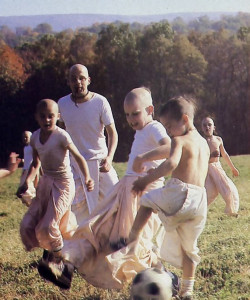
Bhurijana straightforwardly confessed that he had almost no curriculum and few books. He was planning his lessons one step ahead of the students, developing curricula as he went along. Yet two features of the school particularly impressed me as so intelligently conceived that most of my apprehensions were set to rest. The first was the adoption of the old-fashioned method of the one-room schoolhouse, in which a single teacher can instruct children of all different grades. The students get individual assignments from their teacher, prepare their lessons at their desks, and then one by one bring their completed work to the teacher, who corrects it, instructs them, and sends them back with new assignments. Not only is this an eminently practical method for a small school, but it also frees each student to work at his own pace, without being slowed or rushed by the demands of mass instruction.
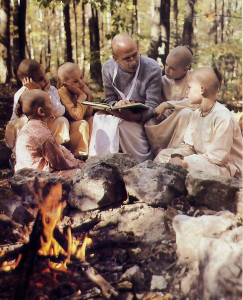
The second impressive feature was the method adopted for teaching the children to read. Before coming to Gita-nagari, Bhurijana, together with Jagadisa dasa, the superintendent for all the gurukula schools, had investigated various programs for teaching reading. They discovered a reading series written by Clarence Barnhart, of dictionary fame, and Leonard Bloomfield, one of the most respected linguists of the century. Bhurijana was enthusiastic: the children learned to read quickly and effortlessly.
“You don’t have any trouble teaching the kids to read?”
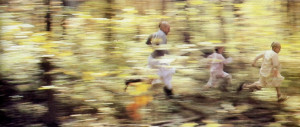
“Not only don’t I have any trouble teaching the kids to read,” he replied, “but the kids don’t have any trouble teaching the kids to read.” Because the system was so logically constructed and simple to use, Bhurijana could assign an older child to lead a younger through the course of exercises. All Bhurijana needed to do was check the progress. The children made excellent reading teachers, Bhurijana said. Endlessly patient, they were not frustrated by slow learners. This tutorial system has become his standard practice; by now my own son has taught half a dozen children to read. By the end of the first grade, every gurukula student can read an adult book like Krsna or The Nectar of Devotion. In this, gurukula has far surpassed public education. “After using this simple system,” Bhurijana recently told me, “you wonder what the whole big fuss is about teaching children to read.”

Over the years I grew close to Bhurijana, coming to know him as the teacher of my child, a colleague in Krsna consciousness and in spiritual education, an exemplar of a wholly dedicated devotee, and a friend.
Bhurijana and I had both gone through college during the turmoil of the sixties, both majored in philosophy; we even turned out to have had a migrating professor in common. In 1964 Bhurijana, then Warren Weinstein, had found himself at the University of Buffalo, a freshman on state scholarship going through the motions of school, wondering what for. But in his sophomore year everything changed: the San Francisco Mime Troupe, psychedelic missionaries, visited campus; Bhurijana pilgrimaged westward with friends to the hippie holy lands; his hair grew longer; he bought a motorcycle. None of this helped his grades.
For Bhurijana the ensuing year was turbulent. There were more treks west, and Bhurijana and his cohorts turned U.B. inside out while everyone tried to figure out what was happening. It was also the time of the Great Spiritual Quest. Since childhood Bhurijana had been attracted to religion and to the feelings worship would awaken in him, yet his milieu could offer no direction for his spiritual strivings. Or in his words, “I was never materialistically inclined: I spent a lot of time at the beach.”
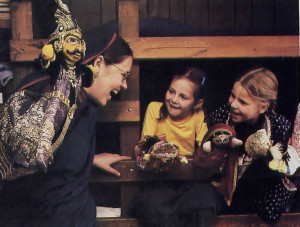
But then in the heady days of the flower children, when the divine became something you could encounter, his early religious feelings came back to life. By his senior year the counterculture had become institutionalized in the U.B. Experimental College. When it offered a course on meditation, Bhurijana signed up, and sitting on the carpet in the back of a crowded room in the student union, he chanted Hare Krsna with Rupanuga dasa, the instructor, a disciple of Srila Prabhupada, the Swami whom Allen Ginsberg used to chant with on the Lower East Side. Bhurijana kept on chanting mornings and evenings in his attic apartment, and when he returned for the next class he considered himself a devotee. His spiritual advancement had been moving at a pathetic crawl, if at all; now he found himself aboard a speeding train.
So Bhurijana became a double dropout: from straight society into the counterculture, from the counterculture into Krsna consciousness. And, in a strange way, by going further out, he came back in: he gave up drugs, his hair became shorter and shorter, and by the time his head was completely shaven—save for the distinctive tuft in the back—he was on the Dean’s List.
In the spring of 1968 he hitched through the melting snow into New York City and spent the weekend at the Hare Krsna temple, seeing Srila Prabhupada for the first time. He wrote about this trip for a course on Utopian fiction. The students had been assigned to create their own Utopia, but Bhurijana began his paper:
“This Utopia is different from other Utopias because it is real.” In Montreal he became Srila Prabhupada’s initiated disciple, and repeating the name “Bhurijana” to himself, he hitched his way back to Buffalo for his last semester. He graduated wearing the twin lines of tilaka on his forehead.
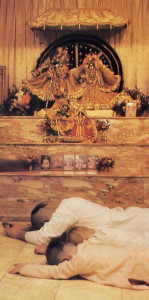
Somewhat later, on New Year’s Day of 1970, we find Bhurijana arriving, to his surprise, in Tokyo, a missionary going to a lonely outpost. In November he left to open a temple in Hong Kong, and by then he had decided he wanted a wife, a devotee wife. This request went back to the large Krsna community in Los Angeles, where, as it happened, a rising young Australian actress had recently cut short her career to join the temple. Jagattarani, known then as Janne Wesly, had made a name for herself in Australian film and television. But she had become increasingly uncomfortable in the roles she played and in the lubricious and meretricious atmosphere of film society. A growing desire for spiritual wholeness led her to visit regularly the small Krsna temple in Sydney; she loved its pure atmosphere. She would do her singing exercises with the Hare Krsna mantra. Then she got a starring role opposite Mick Jagger in a film about an Australian outlaw named Ned Kelly. This was a major production, and on her way to London for its premier she stopped off in Hollywood, staying in the house of one of the Beach Boys. In Hollywood she saw big-time film life, and when she visited the Los Angeles Krsna temple, its purity was a welcome refuge. She asked to stay for a week, and the day Ned Kelly opened with fanfare in London, she moved into the temple for good.
Four months later she was told about a good young devotee about to start a center in Hong Kong who wanted to get married. Would she consider going to serve there, so she could get to know him and, if things worked out, marry him? Her visa was about to expire anyway, so she decided to try it. The day before she left, an Australian reporter came to interview her at the temple. A few months later in Hong Kong she received from her mother a clipping out of Australia’s most popular tabloid: WEIRD CULT FORCES FAMOUS ACTRESS TO MARRY JAPANESE MONK. It was her last press notice. By then she was Bhurijana’s wife.
Now, ten years later, when I visit Bhurijana and Jagattarani in Gita-nagari, I am enlivened to see how fully they express their talents and aptitudes in devotional service. I generally find Jagattarani surrounded by a tumult of busy children, calmly sewing the ornate and intricate costumes for the children’s plays she puts on, all the while directing the multitude of kids through a variety of simultaneous tasks, dominating the scene with striking stage presence, a star surrounded by bit players. Her room is heaped with beautiful hand puppets in various stages of completion. She and her husband put on elaborate puppet versions of scriptural stories, with lavish changes of scenery, rich sound effects, strobe lights, and smoke bombs. Jagattarani creates the puppets and the sets, and Bhurijana writes the scripts. Bhurijana frequently introduces the plays with two popular comic puppets, the sweetly naive Rasgulla and the cynical and gloomy Skurd, who comments on local affairs and members of the audience and brings down the house.
Bhurijana’s responsibilities have steadily increased since I first brought my son to his school. He has a teaching staff of five; forty students, both boys and girls; one more of my children; and a large hew schoolhouse. He regularly visits half a dozen gurukulas on the East Coast, overseeing and advising, and a constant stream of teachers visit Gita-nagari to watch and learn. Bhurijana heads up the curriculum committee for the Hare Krsna movement’s international system of twenty-two gurukulas. In fact, curriculum development has become his real love. “I have such a rare opportunity—the opportunity to build a curriculum from the bottom up and test it at every step. It is an educator’s dream. Krsna fulfills your desires better than you could ever imagine. So many educators would give their very soul, even half their retirement fund, to have my situation.”
Bhurijana has instituted a course of learning for the children that includes intensive Bhagavad-gita study, geography, history, mathematics, nature study, music, current events, Sanskrit, and English. His English curriculum is most interesting; it has developed remarkably, and the clever methods he has adopted to teach composition delight the children. They begin writing essays in the first grade and continue to write at every step. They learn how to observe, organize their impressions and ideas, structure paragraphs, expound thought logically; they learn how to generate ideas by directed free-writing, how to refine and polish their work by rewriting and editing. Bhurijana is training them to come out supremely literate and articulate, to become experts in understanding and in expounding the philosophy of Krsna consciousness.
For Krsna is the context and the goal of all study, all work, all play. Bhurijana continues to teach this daily by his own example. He still lives with the boys, rises early in the morning with them, and remains with them throughout the community’s morning devotions in the temple. He has also built a camp for them in the woods, he takes them swimming and hiking, and he shows them the workings of the farm. “I have the idea,” he says, “that they should remember their childhood as fun.” Thus Bhurijana is creating a special childhood for these children. They are growing up happy, strong, intelligent, self-disciplined, and imbued with the spirit of devotion to Krsna.

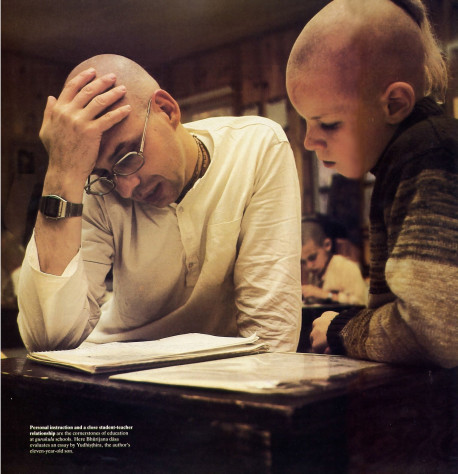
Leave a Reply